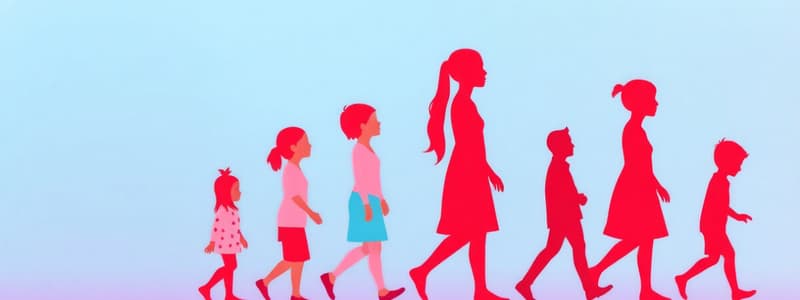Podcast
Questions and Answers
What does the 'traditional' approach to human development primarily emphasize?
What does the 'traditional' approach to human development primarily emphasize?
- The role of genetics in determining developmental outcomes.
- The impact of social and economic factors on development.
- Extensive change from birth to adolescence, stability in adulthood, and decline in old age. (correct)
- Continuous change throughout the entire life-span.
What is meant by the term 'plasticity' in the context of life-span development?
What is meant by the term 'plasticity' in the context of life-span development?
- The potential for change and adaptation throughout life. (correct)
- The fixed biological constraints on development.
- The influence of early childhood experiences on later life.
- The irreversible decline of cognitive abilities with age.
According to Paul Baltes, is development multidimensional?
According to Paul Baltes, is development multidimensional?
- Development depends on individual's physical nature.
- Yes, development is multidimensional (correct)
- Development depends on growth in size only
- No, development is unidimensional
Which of the following is an example of a biological process in development?
Which of the following is an example of a biological process in development?
What does the proximodistal pattern refer to in the context of development?
What does the proximodistal pattern refer to in the context of development?
In what direction does the cephalo-caudal pattern occur?
In what direction does the cephalo-caudal pattern occur?
Which of the following is a characteristic of life-span development?
Which of the following is a characteristic of life-span development?
Development takes place
Development takes place
What processes involve changes in an individual's thought, intelligence, and language?
What processes involve changes in an individual's thought, intelligence, and language?
Which processes include changes in an individual's relationships, emotions, and personality?
Which processes include changes in an individual's relationships, emotions, and personality?
What is meant when development is described as 'contextual'?
What is meant when development is described as 'contextual'?
Which of the following is considered a goal of human development?
Which of the following is considered a goal of human development?
What does 'nature' refer to in the nature versus nurture debate?
What does 'nature' refer to in the nature versus nurture debate?
What does continuity in development refer to?
What does continuity in development refer to?
What does discontinuity in development involve?
What does discontinuity in development involve?
If development is described as involving stability, what does this suggest?
If development is described as involving stability, what does this suggest?
What does it mean if development is best described as involving change?
What does it mean if development is best described as involving change?
Flashcards
Traditional Approach
Traditional Approach
Views development as limited to early life stages and decline in old age.
Life-Span Approach
Life-Span Approach
Belief that development occurs throughout life, including adulthood.
Lifelong Development
Lifelong Development
Human development continues across all life stages, not just childhood.
Plasticity in Development
Plasticity in Development
Signup and view all the flashcards
Multidimensional Development
Multidimensional Development
Signup and view all the flashcards
Orderly Development
Orderly Development
Signup and view all the flashcards
Proximodistal Pattern
Proximodistal Pattern
Signup and view all the flashcards
Cephalocaudal Pattern
Cephalocaudal Pattern
Signup and view all the flashcards
Cognitive processes
Cognitive processes
Signup and view all the flashcards
Socioemotional processes
Socioemotional processes
Signup and view all the flashcards
Interconnected processes
Interconnected processes
Signup and view all the flashcards
Contextual development
Contextual development
Signup and view all the flashcards
Goals of development
Goals of development
Signup and view all the flashcards
Nature vs. Nurture
Nature vs. Nurture
Signup and view all the flashcards
Continuity vs. Discontinuity
Continuity vs. Discontinuity
Signup and view all the flashcards
Stability vs. Change
Stability vs. Change
Signup and view all the flashcards
Developmental characteristics
Developmental characteristics
Signup and view all the flashcards
Milestones in development
Milestones in development
Signup and view all the flashcards
Study Notes
Two Approaches to Human Development
- Traditional Approach: Believes development is primarily focused on childhood, with little change in adulthood and decline in old age.
- Life-Span Approach: Emphasizes continuous development throughout life.
Characteristics of Human Development (Life-Span Perspective)
- Lifelong: Development continues throughout life, not just childhood.
- Plastic: Development is possible at any age; learning is possible at any stage.
- Multidimensional: Development involves biological, cognitive, and socio-emotional factors.
- Biological: Physical changes (height, weight, hormonal changes, cardiovascular decline).
- Cognitive: Changes in thinking, intelligence, and language (from sounds to complex thought).
- Socioemotional: Changes in relationships, emotions, and personality (smiles, frowns, tantrums, to complex relationships).
- Orderly: Development follows predictable patterns (proximodistal and cephalocaudal).
- Gradual: Development is a continuous process, not instant or sudden.
- Contextual: Development is influenced by multiple factors (biological makeup, environment, culture, social context).
- Growth, Maintenance & Regulation: These are the goals of human development (growth in childhood, maintenance & regulation in adulthood).
Nature vs. Nurture
- Nature: Biological inheritance.
- Nurture: Environmental experiences.
Continuity vs. Discontinuity
- Continuity: Gradual, cumulative change (e.g., seedling to tree).
- Discontinuity: Distinct, separate stages (e.g., caterpillar to butterfly).
Stability vs. Change
- Stability: Does early experience determine later behavior? Do we remain the same or change over time?
Studying That Suits You
Use AI to generate personalized quizzes and flashcards to suit your learning preferences.




